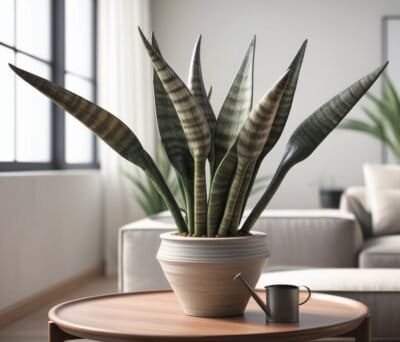Introduction to the Rhino Grass Snake Plant
The rhino grass snake plant, scientifically known as Sansevieria desertii, is a unique and striking member of the snake plant family. Its distinctive appearance sets it apart from other varieties:
- Leaves resemble rhino horns, growing from the base
- Average leaf length: 12-18 inches (30-45 cm)
- Classified as a medium-sized snake plant
- Some varieties feature charming red dots on the leaves
This plant, also known as the rhino snake plant or simply rhino grass plant, has gained popularity among indoor plant enthusiasts for its:
- Elegant and sculptural form
- Low-maintenance nature
- Air-purifying qualities
- Drought-resistant properties
Origins and Classification

Snake plants, including the rhino grass snake plant, have a rich history rooted in the diverse ecosystems of Africa.
Originally thriving in the tropical jungles of West Africa, these resilient plants have adapted to flourish in hot, sunny environments.
Their native range extended from Nigeria to the Congo, where they developed their distinctive characteristics before becoming popular houseplants worldwide.
Taxonomic Journey
Throughout much of its botanical history, this plant genus was known as Sansevieria.
However, in a significant taxonomic shift in 2017, the entire Sansevieria genus was reclassified under the Dracaena genus.
As a result, the scientific name of the common snake plant changed to Dracaena trifasciata. This reclassification reflects our evolving understanding of plant genetics and relationships.
Snake plants belong to the Asparagaceae family, a diverse group that includes many garden favorites. This family connection hints at the plant’s hardy nature and adaptability to various environments.
Diverse Varieties
The snake plant family, including the rhino grass snake plant, showcases remarkable diversity in shape, size, and color patterns. Some popular varieties include:
- Hahnii (Bird’s Nest Snake Plant)
- Laurentii (Variegated Snake Plant)
- Compacta (Dwarf Snake Plant)
- Goldiana (Golden Snake Plant)
- Silbersee (Silver Snake Plant)
These varieties range from compact, low-growing plants to tall, architectural specimens, and even include types with uniquely twisted or wavy leaves.
Cultural Significance
The global popularity of snake plants has led to a variety of cultural names and associations:
- English: “Mother-in-law’s Tongue” (due to its sharp leaves)
- Portuguese: “Espada de São Jorge” (Saint George’s Sword)
- Japanese: “Tiger’s Tail”
These diverse names reflect the plant’s widespread appeal and the different cultural lenses through which it’s viewed.
Scientific Recognition
The importance of snake plants extends beyond their ornamental value. According to NASA’s Clean Air Study, certain varieties of snake plants, particularly the variegated Dracaena trifasciata ‘Laurentii,’ have been recognized for their air-purifying qualities.
This scientific acknowledgment has further boosted the popularity of snake plants, including the rhino grass variety, as beneficial additions to indoor spaces.
As of 2024, ongoing research continues to explore the potential benefits of snake plants in improving indoor air quality and their adaptability to changing environmental conditions, solidifying their place as both decorative and functional elements in modern interiors.
Rhino Grass Snake Plant Care

Caring for your rhino grass plant is straightforward, making it an excellent choice for beginners. Here’s what you need to know:
Light Requirements
- Prefers bright, indirect light
- Can tolerate low light conditions
- Avoid prolonged exposure to direct sunlight, which may scorch the leaves
Soil and Potting
- Use well-draining, sandy soil mix
- Opt for a cactus or succulent potting mix
- Ensure the pot has drainage holes to prevent water logging
Watering
- Allow soil to dry completely between waterings
- Water less frequently in winter (once every 4-6 weeks)
- Overwatering is the primary cause of issues – err on the side of underwatering
Temperature and Humidity
- Ideal temperature range: 60-85°F (15-29°C)
- Can tolerate brief periods of lower temperatures, but avoid prolonged exposure below 50°F (10°C)
- Adapts well to average home humidity levels
Fertilizing
- Feed sparingly during the growing season (spring and summer)
- Use a balanced, water-soluble fertilizer diluted to half strength
- Fertilize once every 2-3 months
Propagation
Rhino grass snake plants can be propagated through:
- Leaf cuttings
- Division of rhizomes
- Offsets (pups) that grow from the base of the plant
Benefits of the Rhino Grass Snake Plant

Beyond its aesthetic appeal, this plant offers several benefits:
- Air Purification: Like other snake plants, it helps remove indoor air pollutants.
- Low Maintenance: Perfect for busy individuals or those new to plant care.
- Drought Tolerance: Can survive occasional neglect and infrequent watering.
- Feng Shui: Believed to bring positive energy and good luck to living spaces.
Common Issues and Solutions
While generally hardy, rhino grass plants may encounter some problems:
- Overwatering: Can lead to root rot. Solution: Reduce watering frequency and ensure proper drainage.
- Pests: Mealybugs and spider mites can occasionally infest. Solution: Treat with neem oil or insecticidal soap.
- Brown or yellow leaves: Often indicate overwatering or exposure to direct sunlight. Adjust care accordingly.
Conclusion
The rhino grass snake plant is a fantastic addition to any indoor plant collection. Its unique appearance, coupled with its easy care requirements, makes it an ideal choice for plant enthusiasts of all levels. Whether you’re a seasoned plant parent or just starting your green journey, the rhino grass plant is sure to bring a touch of exotic elegance to your space.
Remember, while this guide provides general care instructions, always observe your plant’s specific needs and adjust care accordingly. Happy planting!

